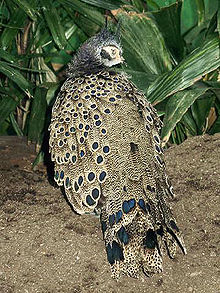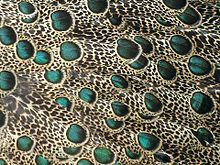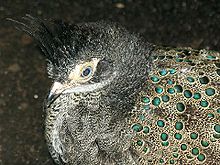- Malayan Peacock-Pheasant
-
Malayan Peacock-Pheasant 
Adult male in Bronx Zoo
Bronx Zoo is one of the leaders of the captive breeding program that attempts to save this species from extinctionConservation status Scientific classification Kingdom: Animalia Phylum: Chordata Class: Aves Subclass: Neornithes Infraclass: Galloanserae Order: Galliformes Family: Phasianidae Subfamily: Phasianinae Genus: Polyplectron Species: P. malacense Binomial name Polyplectron malacense
(Scopoli, 1786)Synonyms Pavo malacensis Scopoli, 1786
Polyplectron bicalcaratum (non Linnaeus, 1758: preoccupied)[verification needed]
Polyplectron malacense malacense (Scopoli, 1786)The Malayan Peacock-Pheasant (Polyplectron malacense) also known as Crested Peacock-Pheasant or Malaysian Peacock-Pheasant, is a medium-sized pheasant of the galliform family Phasianidae. The closely related Bornean Peacock-Pheasant (P. schleiermacheri) was formerly included here as a subspecies, but as understood today, P. malacense is monotypic.[1]
Contents
Description
It is one of the shortest-tailed peacock-pheasants. Adult males are about 50 cm long, about half of which is made up by the tail. Their tarsus measures approximately 6.5 cm, and their wings are 20–21 cm long; they weigh from over 600 to nearly 700 g. Their plumage is generally pale brown with small black spots and bands all over, creating the "salt-and-pepper" effect found in most peacock-pheasants. It has iridescent blue-green eyespots with a buff border on its upperwings, back, and on the 22 rectrices, a white throat running down to the center of the breast, and a loose, pointed and upturned dark blue-green crest on its forehead. A bare facial skin surrounds the eyes with their bluish-white iris; usually pink, it becomes bright orange-red during courtship. The bill and legs are blackish.[2]
The female is slightly smaller than the male, with a noticeably shorter tail; measuring about 40 cm overall, its tail is slightly less than 20 cm long, while its tarsus measures c.6 cm and its wing length is 18 cm. Adult Females weigh about 450-550 g. Their plumage is duller than in males, with a vestigial crest and eyespots only on remiges and rectrices. On the wing coverts and back, they have dark dots instead, which are pointed towards the feather tip.[3]
Young birds resemble females but have even less-developed eyespots and usually lack them entirely except on the rectrices. The downy hatchlings are pale chestnut-brown above and buff below.[4]
Systematics
mtDNA cytochrome b and D-loop as well as the nuclear ovomucoid intron G sequence data places the Malayan Peacock-Pheasant within the basal radiation of its genus, together with the even more elusive Bornean Peacock-Pheasant (P. schleiermacheri) – its sister species –, and the even more basal Palawan Peacock-Pheasant (P. napoleonis). The common ancestor of the Malayan and Bornean Peacock-Pheasants probably diverged from its relatives during the Pliocene[5] or maybe Late Miocene, about 5 million years ago (Ma) perhaps.[6]
When the lineages of Borneo and Malaya diverged has not been studied; considering the phylogeny of Polyplectron, an Early Pleistocene[5] date, roughly around 1 Ma, seems reasonable. In that regard, it is probably significant that Borneo was connected to the Southeast Asian mainland during Pleistocene glacial periods with low sea levels. In any case, the phylogeny and biogeography of the basal peacock-pheasants agrees with the idea of reproductive isolation due to rising sea levels during the last ice age's interglacials, whereas the more advanced Polyplectron species are limited to today's mainland Southeast Asia.[6]
Ecology
A shy and elusive bird, the Malayan Peacock-Pheasant is endemic to lowland forests of the Malay Peninsula form the Isthmus of Kra region southwards. At one time, this species was widespread in Malaysia and Thailand, and reported from southern Myanmar, Sumatra and Singapore, but it probably never occurred in the former two at least in historic times. It has since disappeared from most of its former range, with the remaining population being confined to the lowlands of central Malaysia, perhaps extending barely into Thailand. Although nothing certain is known, there is nothing to suggest that this species is anything other than a sedentary bird; individuals probably do not move a long distance from their place of hatching. They are somewhat territorial, but the ranges of several birds probably overlap except for the core areas. Males move about in an area of approximately 10–60 hectares, while the ranges of females are half that size. The average population density in suitable habitat is estimated as slightly less than seven adult birds per square kilometer.[4]
It inhabits mainly dipterocarp rainforest up to 150 m ASL, rarely occurring even as low as 300 m ASL. While it can utilize secondary forest, such habitat does not seem to be optimal. Its feeding habits are little-studied, but it probably eats a mix of plant matter (particularly fruits) and small arthropods like its better-known relatives. It forages in typical galliform fashion, by scratching and pecking just like an ordinary farmyard chicken. Recorded food items include insects such as Diptera, Orthoptera and Hymenoptera (e.g. carpenter ants, Camponotus[7]), and fruits and seeds of Annonaceae, Fabaceae and Fagaceae (e.g. stone oaks, Lithocarpus). Other items found in Malayan Peacock-Pheasant stomachs were probably not ingested deliberately; they include moss, twigs, rootlets and part of an Apocynaceae flower.[4]
 Adult male's mantle feathers with their eyespots and "salt-and-pepper" pattern
Adult male's mantle feathers with their eyespots and "salt-and-pepper" pattern
Reproduction
Malayan Peacock-Pheasants are polygynous or promiscuous, and do not form lasting pair bonds. The mating season is not well resolved; recently-used nests have been found in March, April and August. Breeding activity may in fact occur essentially all year round (as in many lowland rainforest birds), triggered by abundance of mast rather than by a fixed circannual rhythm. Males scrape the debris and leaf litter off their display sites in forest clearings, from where they call to attract females. They show off the large eyespots on remiges and rectrices to potential mates while standing in their display, both while facing them and alongside them.[6]
As usual for Galliformes, the males' contribution to reproduction ends after copulation. The nest is very vestigial, consisting just of a few twigs and large leaves scraped together on low-lying firm ground, be it on a termite mound a short distance above the forest floor, or the forest floor itself. P. malacense is one of the few pheasants known with certainty to have a one-egg clutch. Incubation takes probably 22–23 days. The species is not infrequently bred in zoos.[4]
Status and conservation
Due to ongoing habitat loss, small population size and limited range, the Malayan Peacock-Pheasant is evaluated as Vulnerable on the IUCN Red List of Threatened Species. Its classification is VU A2cd+3 cd+4 cd, meaning that its numbers have declined about two-thirds in the last decade or so, and that this trend is expected to last for another decade at least. It is listed on CITES Appendix II.[1]
Deforestation is the main threat for this species, and has rendered more than half of the places where it was found in the 1970s unsuitable for it. The available habitat has even declined by over three-quarters during that time, indicating that the population – estimated at about 8,000 adults as of 2008 – is close to the maximum possible, as less and less suitable forest is not inhabited by P. malacense. It used to be hunted for food or as a trophy, but compared to deforestation these threats are nearly insignificant nowadays.[1]
While a small amount of selective logging is tolerated by this bird, it depends on sufficient primary forest to persist. Most Malayan Peacock-Pheasants today live in protected areas in Malaysia, namely Taman Negara National Park and Krau Wildlife Reserve in Pahang, and perhaps Sungkai Sambar Deer and Pheasant Wildlife Reserve in Perak and Sungai Dusun Wildlife Reserve in Selangor. There are also a few reports from less strictly-protected areas, such as Pasoh Forest Reserve in Negeri Sembilan. In areas where they receive protection and where suitable habitat is plentiful, the Malayan Peacock-Pheasant can be fairly common, and thus become a flagship species for ecotourism and other forms of sustainable development. A zoo population exists, numbering 189 birds in 35 sites in 1993. Its studbook is maintained by the New York Zoological Society and Wildlife Conservation International. The Department of Wildlife and National Parks of Malaysia is preparing a captive breeding program to bolster the population in reserves and prevent inbreeding depression by release of captive-bred birds.[1]
Footnotes
- ^ a b c d McGowan (1994), BLI (2008)
- ^ McGowan (1994, 1998), Kimball et al. (2001)
- ^ McGowan (1994, 1998)
- ^ a b c d McGowan (1994)
- ^ a b The estimate of divergence times in Kimball et al. (2001) is probably too low, as they use an uncalibrated and outdated molecular clock that is not well-suited for large-bodied birds.
- ^ a b c McGowan (1994), Kimball et al. (2001)
- ^ Campanotus is a lapsus in McGowan (1994)
References
- BirdLife International (BLI) (2008). Polyplectron malacense. In: IUCN 2008. IUCN Red List of Threatened Species. Downloaded on 23 May 2009.
- Kimball, Rebecca T.; Braun, Edward L.; Ligon, J. David; Lucchini, Vittorio & Randi, Ettore (2001): A molecular phylogeny of the peacock-pheasants (Galliformes: Polyplectron spp.) indicates loss and reduction of ornamental traits and display behaviours. Biol. J. Linn. Soc. 73(2): 187–198. doi:10.1111/j.1095-8312.2001.tb01356.x PDF fulltext
- McGowan, Philip J.K. (1994): 148. Malaysian Peacock-pheasant. In: del Hoyo, Josep; Elliott, Andrew & Sargatal, Jordi (eds.): Handbook of Birds of the World (Vol.2: New World vultures to Guineafowl): 548, plate 58. Lynx Edicions, Barcelona. ISBN 84-87334-15-6
- McGowan, Philip J.K. (1998): Weights of some birds from the Malaysian forest floor. Forktail 14: 78. PDF fulltext
External links
Categories:- IUCN Red List vulnerable species
- Polyplectron
- Pheasants
- Birds of Malaysia
- Birds of Pakistan
- Birds of Thailand
Wikimedia Foundation. 2010.


